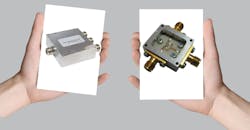Learn the Difference Between a Power Divider and a Power Splitter
While a three-resistor power divider and a two-resistor power splitter are similar components, they have different characteristics. Hence, each is best suited for different use cases—meaning they are not interchangeable. In the short application note “Differences in Application Between Power Dividers and Power Splitters,” Keysight Technologies provides an explanation of both the three-resistor power divider and the two-resistor power splitter before presenting several examples of how they both can be used.
A power divider is a component that equally divides the power of an input signal among multiple output signals. The application note illustrates a three-resistor power divider that consists of three 16 2/3-Ω resistors. Such power dividers are often utilized in test-and-measurement systems. Another point is that this power divider can also function as a power combiner.
The application note also illustrates a two-resistor power splitter that consists of two 50-Ω resistors. This component can be used in leveling loop measurement applications. Utilizing a two-resistor power splitter for source leveling effectively allows for improved source matching.
Next, some applications of both components are presented. For example, a three-resistor power divider can be used to distribute a signal to two different antennas. A power divider can also be used to perform intermodulation-distortion (IMD) measurements. In this scenario, the power divider is actually used as a power combiner. Two signals from two different sources are combined and then applied to a device-under-test (DUT). A spectrum analyzer is used to measure the output of the DUT. Furthermore, diversity gain measurements represent another area of use for power dividers.
The two-resistor power splitter can be used for gain and power testing. The document shows a block diagram of a test setup for an amplifier in which a power splitter is being utilized. As mentioned, leveling or ratioing is another use case for a power splitter. Two block diagrams are presented to illustrate leveling applications. The first one consists of a power splitter and a crystal detector. The second one replaces the crystal detector with a power meter.
Keysight Technologies, 1400 Fountaingrove Pkwy., Santa Rosa, CA 95403-1738; (800) 829-4444

